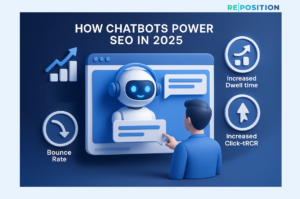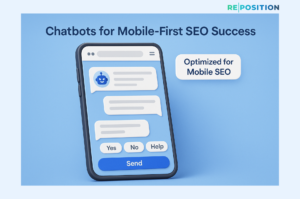The SEO value of chatbots has skyrocketed as businesses race to enhance user experience and climb search engine rankings. In 2025, conversational AI isn’t just a tech trend, it’s an SEO powerhouse. While once seen as a novelty, today’s chatbots are sophisticated tools driving dwell time, decreasing bounce rates, and answering user queries with pinpoint accuracy. All of these are essential signals Google loves. So, what changed? And how can you harness this change to your advantage?

Search engine optimization has evolved beyond stuffing keywords or chasing backlinks. Google now prioritizes user intent, interaction quality, and content value, areas where chatbots thrive. When implemented strategically, chatbots can be the difference between a user bouncing in 10 seconds or staying to explore multiple pages. They guide, inform, convert, and optimize.
Conversational AI refers to technologies like chatbots, voice assistants, and live chat automation tools that simulate human-like conversations. Unlike basic FAQ bots, these tools utilize natural language processing (NLP), machine learning (ML), and sentiment analysis to understand user inputs and respond contextually.
These AI-powered interfaces aren’t just reactive. They proactively engage users, understand questions in real-time, and can even suggest content or products, creating a personalized journey that aligns beautifully with Google’s goals for quality search experiences.
Just a few years ago, SEO professionals focused on backlinks, metadata, and keyword density. Now, behavioral metrics, like bounce rate, click-through rate, and session duration, are just as critical. That’s where chatbots shine.
Conversational AI helps maintain user engagement, answers their queries instantly, and even directs them to other pages or resources, increasing the number of clicks and lowering exits. This “assistive” nature makes websites sticky, and Google notices.
Chatbots deliver fast, accurate responses. But their biggest strength? They prevent friction. Users don’t have to search manually through pages; the bot guides them to exactly what they need.
Let’s say a visitor lands on your site looking for pricing details. Instead of navigating menus, a chatbot can immediately answer, “Our premium plan starts at $99/month. Would you like to compare plans?” That’s effective engagement, and it keeps users on-site longer.
Dwell time, the duration users stay on your site before returning to search results, is a subtle yet powerful SEO signal. The longer the dwell time, the more relevant Google deems your content.
Chatbots increase dwell time by:
Each extra minute a user stays because they’re chatting with your AI assistant is another nudge to Google that your content deserves to rank higher.

The on-page SEO potential of chatbots is often underestimated. They:
Plus, chat logs can be mined for valuable keyword ideas. What your audience asks your chatbot reveals the exact phrases they use, gold for content marketers.
Chatbots can influence how users (and eventually bots) interact with your site structure. By guiding users through your pages logically, chatbots indirectly improve crawl patterns. Googlebot follows user behavior. If users are jumping from a chatbot to various internal links, Google sees your site as structured and navigable.

With mobile-first indexing, mobile SEO is critical. Chatbots are inherently mobile-friendly. They:
By reducing the need for typing and offering instant help, chatbots improve mobile user experience, a ranking factor in Google’s eyes.
Search engines reward relevance. And nothing is more relevant than a personalized experience. Chatbots can track user behavior in real-time, pages visited, products viewed, past queries, and adjust responses accordingly.
This type of behavioral SEO strategy aligns content with user intent, improving click-through rates and engagement.
With the rise of voice search, long-tail and conversational queries are booming. Chatbots are naturally attuned to these. They understand context, slang, even regional dialects.
Integrating chatbots helps you optimize for natural language queries, a crucial factor for future-proofing your SEO.
Beyond support, chatbots act as sales assistants. They:
This not only boosts conversions but also sends signals to search engines that users find your site useful, leading to improved rankings.
Every chatbot interaction is data-rich. You learn:
This insight allows you to adjust your SEO strategy, update content, create new pages, and optimize keywords.
For local businesses, chatbots answer questions like:
Chatbots can sync with Google Business Profiles, ensuring your local SEO stays on point while providing excellent user experience.
Chatbots can generate structured, question-based content, perfect for capturing featured snippets. For example:
Feed these queries into your content strategy and watch your visibility increase.
From awareness to decision, chatbots can lead the entire journey. They act as a friendly guide, decreasing friction and building trust, a key driver in SEO authority and conversion.
E-commerce sites benefit hugely:
All while gathering rich SEO signals through interaction depth and user intent.
Multilingual bots break down language barriers. They allow international visitors to explore content comfortably, boosting your global reach and reducing bounce rates in foreign regions.
When users can ask questions anytime, especially in different time zones, they’re more likely to stay. This continuity improves session duration and sends positive signals to search engines.
Returning visitors spend more time and interact more. Chatbots that remember past interactions build relationships, increase visits, and solidify your authority, key for long-term SEO.
Chatbots can be programmed to use structured data to improve:
This results in enhanced SERP features and higher click-through rates.
Semantic SEO focuses on meaning, not just keywords. Chatbots understand context and tailor answers accordingly, perfect for satisfying semantic search queries.
Real-time suggestions from chatbots guide users deeper into your content, increasing time on site and page views per session.
While they can’t build backlinks, chatbots help by:
When chatbots handle 80% of repetitive queries, you save money while enhancing site functionality and improving SEO metrics.
Track interaction heatmaps, questions asked, drop-off points, use this to fine-tune your SEO content and structure.
From lead qualification to guiding whitepaper downloads, B2B chatbots help create value-rich interactions that convert, and rank.
When linked to your CRM, chatbots gather first-party data that you can use to craft keyword strategies and hyper-targeted content.
A secure chatbot earns user trust. Trust increases return visits, reviews, and user-generated content, factors that feed into SEO success.
Avoid:
Always test and tweak your bot’s tone, flow, and functionality.
AI will become more conversational, personalized, and embedded in SEO strategies. With Google’s continued emphasis on helpful content, chatbots will serve as frontline content delivery tools, bridging users and brands.
To summarize, the SEO value of chatbots in 2025 is not just a prediction, it’s a reality. They enhance user experience, gather data, personalize journeys, and offer conversational interfaces that align with search engine preferences. In the evolving SEO landscape, they’re not optional, they’re essential.
How do chatbots help with SEO?
They improve user engagement, lower bounce rates, and increase dwell time, critical SEO signals.
Do chatbots affect keyword strategy?
Yes. User queries collected via chatbots inform your keyword and content planning.
Are chatbots good for mobile SEO?
Absolutely. They’re optimized for mobile interaction and enhance mobile-first indexing.
Can chatbots impact local SEO?
Yes. They answer location-based queries and integrate with local listings.
Do chatbots help with featured snippets?
They can generate structured Q&A data perfect for snippet capture.
Is it possible to use chatbots for link building?
Indirectly, yes. By increasing content discoverability and encouraging shares.